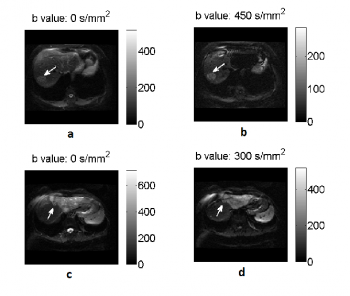Overview: Software to segment and quantify the apparent diffusion coefficient (ADC) from diffusion MR images
Software description: The ADC value of tumors estimated using diffusion MRI is emerging as an important biomarker for monitoring cancer response. We developed novel statistical methods to segment lesions in DW images and estimate a single ADC value of the lesion. The ADC estimation procedure we designed was more accurate than state-of-the-art ADC estimation procedures.

Validation: The segmentation method was validated by comparing with manual segmentations. Also, the ADC estimation method was validated using realistic simulation studies, where it was observed that the proposed methods were highly accurate and outperformed existing methods including at very low signal-to-noise ratio values.
Finally, the value of the methods that we developed were assessed using a prospective clinical study. It was observed that the application of these methods was important for diffusion MRI to serve as a restrictive predictive biomarker of the therapeutic response of liver metastasis.
Software link: Please mail a dot jha at wustl dot edu to get access to this software
References: Please cite the following references when using this software.
Segmentation method:
- R. M. Stephen, A. K. Jha, D. J. Roe, et al., “Diffusion MRI with Semi-Automated Segmentation Can Serve as a Restricted Predictive Biomarker of the Therapeutic Response of Liver Metastasis”, Magn. Res. Imag., 33(10), 1267-33, 2015 (pdf)
- A. K. Jha, J. J. Rodriguez, R. M. Stephen, A. T. Stopeck, “A clustering algorithm for liver lesion segmentation of diffusion-weighted MR images”, Proc. IEEE Southwest Symp. Image Anal. Interpret., pp. 93-6, 2010 (link)
ADC estimation method:
- A. K. Jha, J. J. Rodriguez, A. T. Stopeck, “A maximum-likelihood method to estimate a single ADC value of lesions using diffusion MRI”, Mag. Res. Med., 76(6), 2016 (pdf)
Creators: This software was developed in efforts led by Abhinav Jha in collaboration with Arizona Cancer Center at the University of Arizona, and in the lab of Dr. Jeffrey Rodriguez.